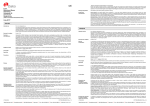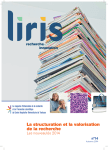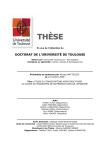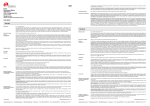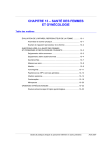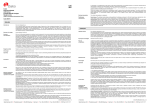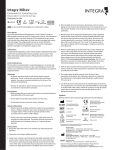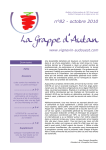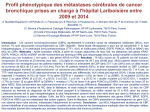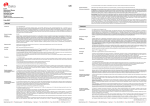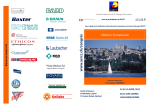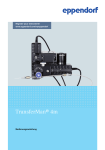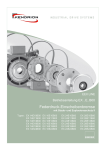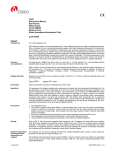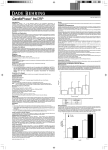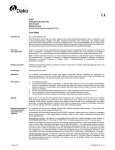Download Monoclonal Mouse
Transcript
FLEX Monoclonal Mouse Anti-Human E-Cadherin Clone NCH-38 Ready-to-Use (Dako Autostainer/Autostainer Plus) Code IS059 English Intended use For in vitro diagnostic use. FLEX Monoclonal Mouse Anti-Human E-Cadherin, Clone NCH-38, Ready-to-Use, (Dako Autostainer/Autostainer Plus), is intended for use in immunohistochemistry together with Dako Autostainer/Autostainer Plus instruments. This antibody is useful for the identification of E-cadherin positive cells in normal and neoplastic tissues and for the differentiated diagnosis between ductal carcinoma and lobular carcinoma of the breast. The clinical interpretation of any staining or its absence should be complemented by morphological studies using proper controls and should be evaluated within the context of the patient's clinical history and other diagnostic tests by a qualified pathologist. Synonyms for antigen E-CD, uvomorulin, L-CAM, Arc-1, or cell-CAM 120/180 (1-3) Summary and explanation E-cadherin is a 120 kDa transmembrane cell adhesion molecule. The gene has been localized on chromosome 16q22.1. In its extracellular domain, E-cadherin is involved in cell-cell adhesion through calcium-regulated homophilic interactions, whereas in its intracellular domain, E-cadherin connects to the actin cytoskeleton via catenins. E-cadherin has a significant function in intercellular adhesion of epithelial cells, the establishment of epithelial polarization, glandular differentiation, and stratification. It is localized mainly in the adherens junctions and concentrates the urokinase plasminogen and the epidermal growth factor receptor to cell contact sites (5,6). Down-regulation of E-cadherin expression has been observed in a number of carcinomas and is usually associated with advanced stage and progression (5-8). Refer to Dako’s General Instructions for Immunohistochemical Staining or the detection system instructions of IHC procedures for: 1) Principle of Procedure, 2) Materials Required, Not Supplied, 3) Storage, 4) Specimen Preparation, 5) Staining Procedure, 6) Quality Control, 7) Troubleshooting, 8) Interpretation of Staining, 9) General Limitations. Reagent provided Ready-to-use monoclonal mouse antibody provided in liquid form in a buffer containing stabilizing protein and 0.015 mol/L NaN3. Clone: NCH-38 Isotype: IgG1, kappa Immunogen E-cadherin (uvomorulin) and GST recombinant protein (4) Specificity Anti-E-cadherin, NCH-38 recognizes the 120 kDa mature form and 82 kDa fragment of E-cadherin in Western blots of A431 cells lysates (4). Precautions 1. For professional users. 2. This product contains sodium azide (NaN3), a chemical highly toxic in pure form. At product concentrations, though not classified as hazardous, sodium azide may react with lead and copper plumbing to form highly explosive build-ups of metal azides. Upon disposal, flush with large volumes of water to prevent metal azide build-up in plumbing. 3. As with any product derived from biological sources, proper handling procedures should be used. 4. Wear appropriate Personal Protective Equipment to avoid contact with eyes and skin. 5. Unused solution should be disposed of according to local, State and Federal regulations. Storage Store at 2-8 °C. Do not use after expiration date stamped on vial. If reagents are stored under any conditions other than those specified, the conditions must be verified by the user. There are no obvious signs to indicate instability of this product. Therefore, positive and negative controls should be run simultaneously with patient specimens. If unexpected staining is observed which cannot be explained by variations in laboratory procedures and a problem with the antibody is suspected, contact Dako Technical Support. Specimen preparation including materials required but not supplied The antibody can be used for labeling formalin-fixed, paraffin-embedded tissue sections. Tissue specimens should be cut into sections of approximately 4 µm. (117394-001) Pre-treatment with heat-induced epitope retrieval (HIER) is required. Optimal results are obtained by pretreating tissues using EnVision FLEX Target Retrieval Solution, High pH (10x) (Dako Autostainer/Autostainer Plus) (Code K8012/K8014). 307134EFG_001 p. 1/11 Deparaffinized sections: Pre-treatment of deparaffinized formalin-fixed, paraffin-embedded tissue sections is recommended using Dako PT Link (Code PT100/PT101). For details, please refer to the PT Link User Guide. Follow the pre-treatment procedure outlined in the package insert for EnVision FLEX Target Retrieval Solution, High pH (10x) (Dako Autostainer/Autostainer Plus) (Code K8012/K8014). The following parameters should be used for PT Link: Pre-heat temperature: 65 °C; epitope retrieval temperature and time: 97 °C for 20 (±1) minutes; cool down to 65 °C. Rinse sections with diluted room temperature EnVision FLEX Wash Buffer (10x) (Dako Autostainer/Autostainer Plus) (Code K8012). Paraffin-embedded sections: As alternative specimen preparation, both deparaffinization and epitope retrieval can be performed in the PT Link using a modified procedure. See the PT Link User Guide for instructions. After the staining procedure has been completed, the sections must be dehydrated, cleared and mounted using permanent mounting medium. The tissue sections should not dry out during the treatment or during the following immunohistochemical staining procedure. For greater adherence of tissue sections to glass slides, the use of Dako Silanized Slides (Code S3003) is recommended. Staining procedure including materials required but not supplied The recommended visualization system is EnVision FLEX+, Mouse, High pH (Dako Autostainer/Autostainer Plus) (Code K8012). The staining steps and incubation times are pre-programmed into the software of Dako Autostainer/Autostainer Plus instruments, using the following protocols: Template protocol: FLEXRTU2 (200 uL dispense volume) or FLEXRTU3 (300 uL dispense volume) Autoprogram (without counterstaining): E-Cad or Autoprogram (with counterstaining): E-CadH The Auxiliary step should be set to “rinse buffer” in staining runs with ≤10 slides. For staining runs with >10 slides the Auxiliary step should be set to “none.” This ascertains comparable wash times. All incubation steps should be performed at room temperature. For details, please refer to the Operator’s Manual for the dedicated instrument. If the protocols are not available on the used Dako Autostainer instrument, please contact Dako Technical Services. Optimal conditions may vary depending on specimen and preparation methods, and should be determined by each individual laboratory. If the evaluating pathologist should desire a different staining intensity, a Dako Application Specialist/Technical Service Specialist can be contacted for information on re-programming of the protocol. Verify that the performance of the adjusted protocol is still valid by evaluating that the staining pattern is identical to the staining pattern described in “Performance characteristics.” Counterstaining in hematoxylin is recommended using EnVision FLEX Hematoxylin (Dako Autostainer/Autostainer Plus) (Code K8018). Non-aqueous, permanent mounting medium is recommended. Positive and negative controls should be run simultaneously using the same protocol as the patient specimens. The positive control tissue should include epithelial cells and the cells/structures should display reaction patterns as described for this tissue in “Performance characteristics” in all positive specimens. The recommended negative control reagent is FLEX Negative Control, Mouse (Dako Autostainer/Autostainer Plus) (Code IS750). Staining interpretation The cellular staining pattern is membranous and/or cytoplasmic. Performance characteristics Normal tissues: E-cadherin expression has been demonstrated by immunohistochemistry in (40/40) normal urothelium specimens (frozen and paraffin) (8). Normal human mammary gland has been found to strongly express E-cadherin in the intercellular borders of the luminal cells of both the interlobular ducts and the intralobular terminal ducts and ductules but expression was much weaker in myoepithelial cells of ducts and ductules (frozen and paraffin) (10). Squamous epithelial cells in esophagus were found to be strongly immunoreactive (15/15) on cell-cell boundaries, except in the most superficial keratinizing layer. Also, E-cadherin was immunolocalized in normal gastric mucosa at the cell-cell boundaries of the foveolar epithelia as well as in gastric crypts and deep gastric glands (paraffin) (1,2). E-cadherin immunoreactivity has been localized in normal skin along the lateral and upper surfaces of basal keratinocytes at intercellular borders but was absent at the basal cell surface. In the suprabasal layers of skin, E-cadherin expression was localized uniformly around the periphery of the cells, however no expression was seen the superficial corneal layer. The adnexal structures of skin also demonstrated E-cadherin immunoreactivity including membrane staining of the outer root sheath cells (the inner sheath cells were negative), acinar germinative cells in the sebaceous glands and sweat gland cells of skin. No E-cadherin expression was demonstrated in the dermis of normal skin (paraffin) (5). Abnormal tissues: E-cadherin immunoreactivity has been demonstrated in a variety of abnormal cell types (1-3,510). Table 1 summarizes expression of E-cadherin in abnormal tissues. (117394-001) 307134EFG_001 p. 2/11 Table 1. Abnormal Tissue Reactivity Tissue Type Bladder: Primary transitional cell carcinoma of the bladdera,b Breast cancer: Node negativeb (without chemotherapy or hormonal therapy) Breast carcinoma: Ductala,b Breast carcinoma: Lobulara,b Esophagus: Squamous cell carcinomaa Gastric carcinomab Endometriosisa Skin: Melanocytic naevib Skin: Malignant melanomab Prostate cancer: Primary tumorsa (117394-001) Positive and Negative Tissue Element Staining and Staining Pattern 13/40 positive, homogenous (membranous) 13/40 positive, heterogeneous 14/40 negative High Grade (grade IIb and III): 10/24 positive Low Grade (grade I and IIa): 16/16 positive Superficial stage (Ta and Ti): 21/22 positive Invasive stage (T2, T3 and T4): 5/18 positive 136/168 positive 55/87a strong positive, majority of cells 29/87a weaker positive, heterogeneous 14/24b strong positive, majority of cells 10/24b weaker positive, heterogeneous 3/21a positive focal—very sparse intercellular membrane— or weak cytoplasmic 3/14b positive, focal—very sparse intercellular membrane— or weak cytoplasmic 4/15 positive 10/15 positive, heterogeneous or weak 108/413 positive, homogenous linear expression and comparable to normal gastric mucosa 95/413 positive, moderately reduced linear or dotted intercellular staining in 20–60% tumor cells 86/413 positive, highly reduced finely dotted intercellular staining in <20% cells 124/413 negative or weak dotted immunoreactivity <5% cells Special pattern of E-cadherin expression was present in a small percentage of signet ring-cell carcinomas and of undifferentiated carcinomas, where a strong intracytoplasmic “plaque-like” expression of E-cadherin could be demonstrated, sometimes in combination with a very weak immuno-reactivity at tumor-cell membrane. 3/9 positive 6/9 positive, heterogeneous 20/20 positive membranous, superficial compartment of naevi and at the borders between naevus cell nests and keratinocytes of the surrounding epidermis. Junctional naevus cell nests were more heterogeneous than in the epidermal component or diffusely cytoplasmic. Melanocytic cells in the papillary dermis were negative. 13/70 positive, membranous 30/70 positive, heterogeneous 11/70 cytoplasmic 16/70 negative Immunoreactivity associated with histological types of melanomas: 1/34 superficial spreading melanoma-positive, membranous 18/34 superficial spreading melanoma-positive, heterogeneous 8/34 superficial spreading melanoma-cytoplasmic 7/34 superficial spreading melanoma-negative 3/8 nodular melanoma-positive, heterogeneous 2/8 nodular melanoma-cytoplasmic 3/8 nodular melanoma-negative 4/9 lentigo malignant melanoma-positive, heterogenous 1/9 lentigo malignant melanoma-cytoplasmic 4/9 lentigo malignant melanoma-negative 1/8 lentiginous melanoma-positive, membranous 5/8 lentiginous melanoma-positive, heterogeneous 2/8 lentiginous melanoma-negative 11/11 metastic melanoma-positive, membranous 44/84 positive, homogeneous 27/84 positive, heterogeneous 13/84 negative 307134EFG_001 p. 3/11 Metastatic lesionsa 2/8 positive, homogeneous 5/8 positive, heterogeneous 1/8 negative Most differentiated cancers demonstrated strong and uniformly positive immunoreactivity at the cell-cell boundaries, whereas an increasing percentage of less well differentiated to poorly differentiated tumors demonstrated heterogeneous or negative immunoreactivity. a Testing was performed on cryostat sections b Testing was performed on paraffin-embedded formalin-fixed tissue sections Français Réf. IS059 Utilisation prévue Pour utilisation diagnostique in vitro. FLEX Monoclonal Mouse Anti-Human E-Cadherin, clone NCH-38, Ready-to-Use, (Dako Autostainer/Autostainer Plus), est destiné à une utilisation en immunohistochimie avec les instruments Dako Autostainer/Autostainer Plus. Cet anticorps est utile pour l’identification des cellules positives à la E-cadhérine dans les tissus sains et néoplasiques et pour le diagnostic différencié entre le carcinome canalaire et le carcinome lobulaire du sein. L’interprétation clinique de toute coloration ou son absence doit être complétée par des études morphologiques en utilisant des contrôles appropriés et doit être évaluée en fonction des antécédents cliniques du patient et d’autres tests diagnostiques par un pathologiste qualifié. Synonymes de l’antigène E-CD, uvomoruline, L-CAM, Arc-1, ou CAM cellulaire 120/180 (1-3) Résumé et explication La E-cadhérine est une molécule d’adhésion cellulaire transmembranaire de 120 kDa. Le gène a été localisé sur le chromosome 16q22.1. Dans son domaine extracellulaire, la E-cadhérine est impliquée dans l’adhésion cellulecellule via des interactions homophiles régulées par le calcium tandis que, dans son domaine intracellulaire, la E-cadhérine se connecte au cytosquelette d’actine via des caténines. La E-cadhérine a une fonction importante dans l’adhésion intercellulaire des cellules épithéliales, l’établissement de la polarisation épithéliale, la différenciation glandulaire et la stratification. Elle est localisée principalement dans les jonctions adhérentes et elle concentre le plasminogène urokinase et le récepteur du facteur de croissance épidermique dans les sites de contacts cellulaires (5,6). Une régulation à la baisse de l’expression de la E-cadhérine a été observée dans plusieurs carcinomes et est habituellement associée à un stade et une évolution avancés (5-8). Se référer aux Instructions générales de coloration immunohistochimique de Dako ou aux instructions du système de détection relatives aux procédures IHC pour plus d’informations concernant les points suivants : 1) Principe de procédure, 2) Matériels requis mais non fournis, 3) Conservation, 4) Préparation des échantillons, 5) Procédure de coloration, 6) Contrôle qualité, 7) Dépannage, 8) Interprétation de la coloration, 9) Limites générales. Réactifs fournis Anticorps monoclonal de souris prêt à l’emploi fourni sous forme liquide dans un tampon contenant une protéine stabilisante et 0,015 mol/L d’azide de sodium. Clone : NCH-38 Isotype : IgG1, kappa Immunogène E-cadhérine (uvomoruline) et protéine recombinante GST (4) Spécificité L’anti-E-cadhérine, NCH-38 reconnaît la forme mature de 120 kDa et le fragment de 82 kDa de E-cadhérine dans les Western blots de lysats de cellules A431 (4). Précautions 1. Pour utilisateurs professionnels. 2. Ce produit contient de l’azide de sodium (NaN3), produit chimique hautement toxique dans sa forme pure. Aux concentrations du produit, bien que non classé comme dangereux, l’azide de sodium peut réagir avec le cuivre et le plomb des canalisations et former des accumulations d’azides métalliques hautement explosifs. Lors de l’élimination, rincer abondamment à l’eau pour éviter toute accumulation d’azide métallique dans les canalisations. 3. Comme avec tout produit d’origine biologique, des procédures de manipulation appropriées doivent être respectées. 4. Porter un vêtement de protection approprié pour éviter le contact avec les yeux et la peau. 5. Les solutions non utilisées doivent être éliminées conformément aux réglementations locales et nationales. Conservation Conserver entre 2 et 8 °C. Ne pas utiliser après la date de péremption imprimée sur le flacon. Si les réactifs sont conservés dans des conditions autres que celles indiquées, celles-ci doivent être validées par l’utilisateur. Il n’y a aucun signe évident indiquant l’instabilité de ce produit. Par conséquent, des contrôles positifs et négatifs doivent être testés en même temps que les échantillons de patient. Si une coloration inattendue est observée, qui ne peut être expliquée par un changement des procédures du laboratoire, et en cas de suspicion d’un problème lié à l’anticorps, contacter l’assistance technique de Dako. (117394-001) 307134EFG_001 p. 4/11 Préparation des échantillons y compris le matériel requis mais non fourni L’anticorps peut être utilisé pour le marquage des coupes de tissus inclus en paraffine et fixés au formol. L'épaisseur des coupes d'échantillons de tissu doit être d’environ 4 µm. Le prétraitement avec un démasquage d’épitope induit par la chaleur (HIER) est nécessaire. Des résultats optimaux sont obtenus en prétraitant les tissus à l’aide de la EnVision FLEX Target Retrieval Solution, High pH (10x), (Dako Autostainer/Autostainer Plus) (Réf. K8012/K8014). Coupes déparaffinées : Le pré-traitement des coupes de tissus déparaffinés fixés au formol et inclus en paraffine est recommandé à l’aide du Dako PT Link (Réf. PT100/PT101). Pour plus de détails, se référer au Guide d’utilisation du PT Link. Suivre la procédure de pré-traitement indiquée dans la notice pour la EnVision FLEX Target Retrieval Solution, High pH (10x), (Dako Autostainer/Autostainer Plus) (Réf. K8012/K8014). Les paramètres suivants doivent être utilisés pour le PT Link : Température de préchauffage : 65 °C; température et durée de restauration de l’épitope : 97 °C pour 20 (±1) minutes ; laisser refroidir jusqu’à 65 °C. Rincer les coupes avec un EnVision FLEX Wash Buffer (10x), dilué à température ambiante (Dako Autostainer/Autostainer Plus) (Réf. K8012). Coupes incluses en paraffine : Comme préparation alternative des échantillons, le déparaffinage et la restauration de l’épitope peuvent être réalisés dans le PT Link à l’aide d’une procédure modifiée. Se référer aux instructions du Guide d’utilisation du PT Link. Une fois que la procédure de coloration est terminée, les coupes doivent être déshydratées, lavées et montées à l’aide d’un milieu de montage permanent. Les coupes de tissus ne doivent pas sécher lors du traitement ou lors de la procédure de coloration immunohistochimique suivante. Pour une meilleure adhérence des coupes de tissus sur les lames de verre, il est recommandé d’utiliser des lames Dako Silanized Slides (Réf. S3003). Procédure de coloration y compris le matériel requis mais non fourni Le système de visualisation recommandé est le EnVision FLEX+, Mouse, High pH (Dako Autostainer/Autostainer Plus) (Réf. K8012). Les étapes de coloration et d’incubation sont préprogrammées dans le logiciel des instruments Dako Autostainer/Autostainer Plus, à l’aide des protocoles suivants : Protocole modèle : FLEXRTU2 (volume de distribution de 200 µl) ou FLEXRTU3 (volume de distribution de 300 µl) Autoprogram (sans contre-coloration) : E-Cad ou Autoprogram (avec contre-coloration) : E-CadH L’étape Auxiliary doit être réglée sur « rinse buffer » lors des cycles de coloration avec ≤10 lames. Pour les cycles de coloration de >10 lames, l’étape Auxiliary doit être réglée sur « none ». Cela confirme des temps de lavage comparables. Toutes les étapes d’incubation doivent être effectuées à température ambiante. Pour plus de détails, se référer au Manuel de l’opérateur spécifique à l'instrument. Si les protocoles ne sont pas disponibles sur l’instrument Dako Autostainer utilisé, contacter le service technique de Dako. Les conditions optimales peuvent varier en fonction du prélèvement et des méthodes de préparation, et doivent être déterminées par chaque laboratoire individuellement. Si le pathologiste qui réalise l’évaluation désire une intensité de coloration différente, un spécialiste d’application/spécialiste du service technique de Dako peut être contacté pour obtenir des informations sur la re-programmation du protocole. Vérifier que l'exécution du protocole modifié est toujours valide en vérifiant que le schéma de coloration est identique au schéma de coloration décrit dans les « Caractéristiques de performance ». Il est recommandé d’effectuer une contre-coloration à l’aide d’hématoxyline EnVision FLEX Hematoxylin, (Dako Autostainer/Autostainer Plus) (Réf. K8018). L’utilisation d’un milieu de montage permanent non aqueux est recommandée. Des contrôles positifs et négatifs doivent être réalisés en même temps et avec le même protocole que les échantillons du patient. Le contrôle de tissu positif doit comprendre des cellules épithéliales et les cellules/structures doivent présenter des schémas de réaction tels que décrits pour ces tissus dans les « Caractéristiques de performance » pour tous les échantillons positifs. Le contrôle négatif recommandé est le FLEX Negative Control, Mouse, (Dako Autostainer/Autostainer Plus) (Réf. IS750). Interprétation de la coloration Le schéma de coloration cellulaire est cytoplasmique et/ou membranaire. Caractéristiques de performance Tissus sains : L’expression de la E-cadhérine a été démontrée par immunohistochimie dans (40/40) échantillons normaux d’urothélium (congelés et inclus en paraffine) (8). La glande mammaire humaine saine a fortement exprimé la E-cadhérine au niveau des bordures intercellulaires des cellules luminales à la fois des canaux interlobulaires et des canaux et ductules intralobulaires terminaux mais l’expression était nettement plus faible dans les cellules myoépithéliales des canaux et ductules (congelées et incluses en paraffine) (10). Les cellules épithéliales squameuses de l’œsophage se sont révélées fortement immunoréactives (15/15) sur les bordures cellule-cellule, excepté dans la couche kératinisante la plus superficielle. De même, la E-cadhérine a été immunolocalisée dans la muqueuse gastrique saine au niveau des bordures cellule-cellule de l’épithélium fovéolaire, ainsi que dans les cryptes gastriques et les glandes gastriques profondes (paraffine) (1,2). L’immunoréactivité de la E-cadhérine a été localisée dans les tissus de peau sains le long des surfaces latérales et supérieures des kératinocytes basaux au niveau des bordures intercellulaires mais était absente de la surface (117394-001) 307134EFG_001 p. 5/11 basale de la cellule. Dans les couches suprabasales de la peau, l’expression de la E-cadhérine était localisée uniformément autour de la périphérie des cellules ; cependant, aucune expression n’a été observée sur la couche cornéenne superficielle. Les structures annexielles de la peau ont également démontré l’immunoréactivité de la E-cadhérine, incluant la coloration membranaire de l’enveloppe extérieure des cellules (les enveloppes intérieures des cellules étaient négatives), des cellules acinaires germinatives dans les glandes sébacées et des cellules des glandes sudoripares de la peau. Aucune expression de la E-cadhérine n’a été démontrée dans le derme de la peau saine (paraffine) (5). Tissus tumoraux : L’immunoréactivité de la E-cadhérine a été démontrée dans plusieurs types de cellules anormales (1-3,5-10). Le Tableau 1 résume l’expression de la E-cadhérine dans les tissus malins. Tableau 1. Réactivité des tissus anormaux Type de tissu Vessie : Carcinome primaire à cellules transitionnelles de la vessiea,b Cancer du sein : Négatif aux nodulesb (sans chimiothérapie ou traitement hormonal) Carcinome mammaire : Canalairea,b Carcinome mammaire : Lobulairea,b Œsophage : carcinome à cellules squameusesa Carcinome gastriqueb Endométriosea Peau : Naevi mélanocytairesb Peau : Mélanome malinb (117394-001) Coloration d'élément tissulaire positive et négative et schéma de coloration 13/40 positives, homogènes (membranaire) 13/40 positives, hétérogènes 14/40 négatives Haute intensité (grades IIb et III) : 10/24 positives Faible intensité (grades I et IIa) : 16/16 positives Stade superficiel (Ta et Ti) : 21/22 positives Stade invasif (T2, T3 et T4) : 5/18 positives 136/168 positives 55/87a fortement positives, majorité des cellules 29/87a plus faiblement positives, hétérogènes 14/24b fortement positives, majorité des cellules 10/24b plus faiblement positives, hétérogènes 3/21a positives localisés : membrane intercellulaire très peu dense ou cytoplasmique faible 3/14a positives localisés : membrane intercellulaire très peu dense ou cytoplasmique faible 4/15 positives 10/15 positives, hétérogènes ou faibles 108/413 positives, expression linéaire homogène et comparable à la muqueuse gastrique normale 95/413 positives, coloration intercellulaire linéaire modérément réduite ou à points de 20 à 60 % des cellules tumorales 86/413 positives, coloration intercellulaire hautement réduite à points fins dans <20 % des cellules 124/413 négatives ou immunoréactivité faible à points <5 % des cellules Un schéma spécial de l’expression de la E-cadhérine a été observé dans un faible pourcentage de carcinomes à cellules en bague et de carcinomes indifférenciés, où une forte expression intracytoplasmique de type plaque de la E-cadhérine a pu être démontrée, parfois en association à une très faible immunoréactivité au niveau de la membrane cellulaire de la tumeur. 3/9 positives 6/9 positives, hétérogènes 20/20 positives membranaires, compartiments superficiels des naevi et aux bordures entre les nids cellulaires de naevus et les kératinocytes de l’épiderme environnant. Les nids cellulaires de naevus de jonction étaient plus hétérogènes que dans le composant épidermique ou cytoplasmiques diffus. Les cellules mélanocytaires dans le derme papillaire étaient négatives. 13/70 positives, membranaire 30/70 positives, hétérogènes 11/70 cytoplasmiques 16/70 négatives 307134EFG_001 p. 6/11 Immunoréactivité associée aux types histologiques de mélanomes : 1/34 positive au mélanome à extension superficielle, membranaire 18/34 positives au mélanome à extension superficielle, hétérogènes 8/34 positives au mélanome à extension superficielle, cytoplasmiques 7/34 négatives au mélanome à extension superficielle 3/8 positives au mélanome nodulaire, hétérogènes 2/8 mélanomes nodulaires, cytoplasmiques 3/8 négatives au mélanome nodulaire 4/9 positives au mélanome à lentigo malin, hétérogènes 1/9 mélanome à lentigo malin, cytoplasmique 4/9 négatives au mélanome à lentigo malin 1/8 positive au mélanome à lentigo, membranaire 5/8 positives au mélanome à lentigo, hétérogènes 2/8 négatives au mélanome à lentigo 11/11 positives au mélanome métastasique, membranaires Cancer de la prostate : Tumeurs 44/84 positives, homogènes primairesa 27/84 positives, hétérogènes 13/84 négatives a Lésions métastasiques 2/8 positives, homogènes 5/8 positives, hétérogènes 1/8 négative La plupart des cancers différenciés ont présenté une immunoréactivité forte et uniformément positive aux bordures cellulecellule, alors qu’un pourcentage en augmentation de tumeurs moins bien différenciées à mal différenciées a présenté une immunoréactivité hétérogène ou négative. a Les analyses ont été réalisées sur des coupes cryostat b Les analyses ont été réalisées sur des coupes fixées au formol et incluses en paraffine Deutsch Code-Nr. IS059 Zweckbestimmung Zur In-vitro-Diagnostik. FLEX Monoclonal Mouse Anti-Human E-Cadherin, Clone NCH-38, Ready-to-Use, (Dako Autostainer/Autostainer Plus) ist zur Verwendung in der Immunhistochemie in Verbindung mit Dako Autostainer/Autostainer Plus-Geräten bestimmt. Dieser Antikörper dient zur Erkennung von E-Cadherin-positiven Zellen in gesunden und neoplastischen Geweben und zur Unterscheidung zwischen Duktuskarzinomen und lobulären Karzinomen der Brust bei der Diagnose. Die klinische Auswertung einer eventuell eintretenden Färbung sollte durch morphologische Studien mit ordnungsgemäßen Kontrollen ergänzt werden und von einem qualifizierten Pathologen unter Berücksichtigung der Krankengeschichte und anderer Diagnostiktests des Patienten vorgenommen werden. Synonyme für das Antigen E-CD, Uvomorulin, L-CAM, Arc-1 oder Cell-CAM 120/180 (1–3) Zusammenfassung und Erklärung E-Cadherin ist ein 120-kDa-Transmembran-Zelladhäsionsmolekül. Das Gen wurde auf dem Chromosom 16q22.1 lokalisiert. In seiner extrazellulären Domäne ist E-Cadherin an der Zell-Zell-Adhäsion mittels kalziumregulierter homophiler Interaktionen beteiligt, während es sich in seiner intrazellulären Domäne mittels Cateninen an das Aktin-Zytoskelett bindet. E-Cadherin hat eine wesentliche Funktion bei der interzellulären Adhäsion von Epithelzellen, der Einrichtung der Epithelpolarisation sowie der glandulären Differenzierung und Stratifizierung. Es ist hauptsächlich in den adhärenten Verbindungen lokalisiert und konzentriert das Urokinase-Plasminogen und den epidermalen Wachstumsfaktorrezeptor an Zellkontaktstellen (5,6). Eine Abschwächung der E-CadherinExpression wurde in einer Anzahl von Karzinomen beobachtet. Sie steht gewöhnlich in Zusammenhang mit fortgeschrittenem Stadium und Progression (5–8). Folgende Angaben bitte den Allgemeinen Richtlinien zur immunhistochemischen Färbung von Dako oder den Anweisungen des Detektionssystems für IHC-Verfahren entnehmen: 1) Verfahrensprinzip, 2) Erforderliche, aber nicht mitgelieferte Materialien, 3) Aufbewahrung, 4) Vorbereitung der Probe, 5) Färbeverfahren, 6) Qualitätskontrolle, 7) Fehlersuche und -behebung, 8) Auswertung der Färbung, 9) Allgemeine Beschränkungen. Geliefertes Reagenz Gebrauchsfertiger, monoklonaler Maus-Antikörper in flüssiger Form in einem Puffer, der stabilisierendes Protein und 0,015 mol/L NaN3 enthält. Klon: NCH-38 Immunogen (117394-001) Isotyp: IgG1, Kappa E-Cadherin (Uvomorulin) und GST-rekombinantes Protein (4) 307134EFG_001 p. 7/11 Spezifität Anti-E-Cadherin, NCH-38, erkennt die ausgereifte 120-kDa-Form und das 82-kDa-Fragment von E-Cadherin beim Western-Blot von A431-Zelllysaten (4). Vorsichtsmaßnahmen 1. Nur für Fachpersonal bestimmt. 2. Dieses Produkt enthält Natriumazid (NaN3), eine in reiner Form äußerst giftige Chemikalie. Natriumazid kann auch in als ungefährlich eingestuften Konzentrationen mit Blei- und Kupferrohren reagieren und hochexplosive Metallazide bilden. Nach der Entsorgung stets mit viel Wasser nachspülen, um Metallazidansammlungen in den Leitungen vorzubeugen. 3. Wie alle Produkte biologischen Ursprungs müssen auch diese entsprechend gehandhabt werden. 4. Geeignete Schutzkleidung tragen, um Augen- und Hautkontakt zu vermeiden. 5. Nicht verwendete Lösung ist entsprechend örtlichen, bundesstaatlichen und staatlichen Richtlinien zu entsorgen. Lagerung Bei 2–8 °C aufbewahren. Nach Ablauf des auf dem Fläschchen aufgedruckten Verfalldatums nicht mehr verwenden. Werden die Reagenzien unter anderen als den angegebenen Bedingungen aufbewahrt, müssen diese Bedingungen vom Benutzer validiert werden. Es gibt keine offensichtlichen Anzeichen für eine eventuelle Produktinstabilität. Positiv- und Negativkontrollen sollten daher zur gleichen Zeit wie die Patientenproben getestet werden. Falls es zu einer unerwarteten Färbung kommt, die sich nicht durch Unterschiede bei Laborverfahren erklären lässt und auf ein Problem mit dem Antikörper hindeutet, ist der technische Kundendienst von Dako zu verständigen. Vorbereitung der Probe und erforderliche, aber nicht mitgelieferte Materialien Der Antikörper eignet sich zur Markierung von formalinfixierten und paraffineingebetteten Gewebeschnitten. Gewebeproben sollten in Schnitte von ca. 4 µm Stärke geschnitten werden. Die Vorbehandlung durch hitzeinduzierte Epitopdemaskierung (HIER) ist erforderlich. Optimale Ergebnisse können durch Vorbehandlung der Gewebe mit EnVision™ FLEX Target Retrieval Solution, High pH (10x), (Dako Autostainer/Autostainer Plus) (Code-Nr. K8012/K8014) erzielt werden. Entparaffinierte Schnitte: Die Vorbehandlung der entparaffinierten, formalinfixierten, paraffineingebetteten Gewebeschnitte sollte mit Dako PT Link (Code-Nr. PT100/PT101) erfolgen. Weitere Informationen hierzu siehe PT Link-Benutzerhandbuch. Vorbehandlung gemäß der Beschreibung in der Packungsbeilage für EnVision™ FLEX Target Retrieval Solution, High pH (10x) (Dako Autostainer/Autostainer Plus) (Code-Nr. K8012/K8014) durchführen. Für PT Link sollten die folgenden Parameter verwendet werden: Vorwärmtemperatur: 65 °C; Temperatur und Zeit für Epitopdemaskierung: 97 °C für 20 (±1) Minuten; auf 65 °C abkühlen lassen. Schnitte mit auf Raumtemperatur gebrachtem, verdünntem EnVision™ FLEX Wash Buffer (10x) (Dako Autostainer/Autostainer Plus) (Code-Nr. K8012) abspülen. Paraffineingebettete Schnitte: Zur Probenpräparation kann für Entparaffinierung und Epitopdemaskierung im PT Link auch ein modifiziertes Verfahren verwendet werden. Weitere Informationen siehe PT LinkBenutzerhandbuch. Nach Abschluss des Färbeverfahrens müssen die Schnitte dehydriert, geklärt und unter Verwendung eines permanenten Fixiermittels auf die Objektträger aufgebracht werden. Die Gewebeschnitte dürfen während der Behandlung oder während des anschließenden immunhistochemischen Färbeverfahrens nicht austrocknen. Zur besseren Haftung der Gewebeschnitte an den Glasobjektträgern wird die Verwendung von Dako Silanized Slides (Code-Nr. S3003) empfohlen. Färbeverfahren und erforderliche, aber nicht mitgelieferte Materialien Das empfohlene Visualisierungssystem ist EnVision™ FLEX+, Mouse, High pH (Dako Autostainer/Autostainer Plus) (Code-Nr. K8012). Die Färbeschritte und Inkubationszeiten sind in der Software der Dako Autostainer/Autostainer Plus-Geräte mit den folgenden Protokollen vorprogrammiert: Matrix-Protokoll: FLEXRTU2 (200 µl Abgabevolumen) oder FLEXRTU3 (300 µl Abgabevolumen) Autoprogram (ohne Gegenfärbung): E-Cad oder Autoprogram (mit Gegenfärbung): E-CadH Bei Färbedurchläufen mit höchstens 10 Objektträgern sollte der „Zusatz“-Schritt auf „Pufferspülgang“ eingestellt werden. Für Färbedurchläufe mit mehr als 10 Objektträgern den „Zusatz“-Schritt auf „Keine“ einstellen.. Dies gewährleistet vergleichbare Waschzeiten. Alle Inkubationsschritte sollten bei Raumtemperatur durchgeführt werden. Nähere Einzelheiten bitte dem Benutzerhandbuch für das jeweilige Gerät entnehmen. Wenn die Färbeprotokolle auf dem verwendeten Dako Autostainer-Gerät nicht verfügbar sind, bitte den Technischen Kundendienst von Dako verständigen. Optimale Bedingungen können je nach Probe und Präparationsverfahren unterschiedlich sein und sollten vom jeweiligen Labor selbst ermittelt werden. Falls der beurteilende Pathologe eine andere Färbungsintensität wünscht, kann ein Anwendungsspezialist oder Kundendiensttechniker von Dako bei der Neuprogrammierung des Protokolls helfen. Die Leistung des angepassten Protokolls muss verifiziert werden, indem gewährleistet wird, dass das Färbemuster mit dem unter „Leistungsmerkmale“ beschriebenen Färbemuster identisch ist. Die Gegenfärbung in Hämatoxylin sollte mit EnVision™ FLEX Hematoxylin (Dako Autostainer/Autostainer Plus) (Code-Nr. K8018) ausgeführt werden. Empfohlen wird ein nichtwässriges, permanentes Fixiermittel. (117394-001) 307134EFG_001 p. 8/11 Positiv- und Negativkontrollen sollten zur gleichen Zeit und mit demselben Protokoll wie die Patientenproben getestet werden. Das positive Kontrollgewebe sollte Epithelzellen enthalten, und die Zellen/Strukturen müssen in allen positiven Proben die für dieses Gewebe unter „Leistungsmerkmale“ beschriebenen Reaktionsmuster aufweisen. Das empfohlene Negativ-Kontrollreagenz ist FLEX Negative Control, Mouse, (Dako Autostainer/Autostainer Plus) (Code-Nr. IS750). Auswertung der Färbung Das zelluläre Färbemuster ist membranös bzw. zytoplasmatisch. Leistungsmerkmale Gesundes Gewebe: In (40 von 40) gesunden Urothelproben (gefroren und paraffineingebettet) wurde mit Immunhistochemie eine E-Cadherin-Expression nachgewiesen (8). In der gesunden menschlichen Brustdrüse wurde E-Cadherin stark in den interzellulären Grenzen der luminalen Zellen sowohl von interlobulären Gängen als auch intralobulären terminalen Gängen und Kanälen exprimiert. Dagegen war die Expression in Myoepithelzellen der Gänge und Kanäle (gefroren und paraffineingebettet) wesentlich schwächer (10). Plattenepithelzellen in der Speiseröhre zeigten eine starke Immunreaktivität (15 von 15) an Zell-Zell-Grenzen, ausgenommen in der oberflächlichsten keratinisierenden Schicht. Zudem wurde E-Cadherin mittels Immunfärbung in gesunder gastrischer Mukosa an den Zell-Zell-Grenzen der foveolaren Epithel sowie in gastrischen Einbuchtungen und tief liegenden gastrischen Drüsen (paraffineingebettet) nachgewiesen (1,2). In gesunder Haut wurde entlang der lateralen und oberen Oberflächen basaler Keratinozyten an interzellulären Grenzen eine Immunreaktivität von E-Cadherin beobachtet, nicht jedoch an der Basalzell-Oberfläche. In den suprabasalen Hautschichten konnte eine E-Cadherin-Expression gleichmäßig um die Peripherie der Zellen lokalisiert werden, jedoch wurde keine Expression in der oberflächlichen Corneaschicht beobachtet. Die adnexen Strukturen der Haut zeigten ebenfalls eine Immunreaktivität des E-Cadherins, einschließlich einer Membranfärbung der äußeren Wurzelscheidenzellen (die inneren Scheidenzellen reagierten negativ) sowie der azinösen Keimzellen in den Talg- und Schweißdrüsenzellen der Haut. In der Dermis gesunder Haut (paraffineingebettet) wurde keine E-Cadherin-Expression nachgewiesen (5). Pathologisches Gewebe: Eine E-Cadherin-Immunreaktivität wurde in einer Anzahl pathologischer Zelltypen nachgewiesen (1–3, 5–10). Tabelle 1 fasst die Expression von E-Cadherin in pathologischen Geweben zusammen. Tabelle 1. Reaktivität in pathologischen Geweben Gewebetyp Harnblase: primäres ÜbergangszellKarzinom der Harnblasea,b Brustkrebs: Knoten negativb (ohne Chemotherapie oder Hormonbehandlung) Brustkrebs: duktala,b. Brustkrebs: lobulära,b Speiseröhre: Plattenzellkarzinoma Magenkarzinomb Endometriosea (117394-001) Positive und negative Färbung und Färbungsmuster der Gewebeelemente 13 von 40 positiv, homogen (membranös) 13 von 40 positiv, heterogen 14 von 40 negativ Hochgradig (Grad IIb und III): 10 von 24 positiv Niedriggradig (Grad I und IIa): 16 von 16 positiv Oberflächlich (Ta und Ti): 21 von 22 positiv Invasiv (T2, T3 und T4): 5 von 18 positiv 136 von 168 positiv 55 von 87a stark positiv, Großteil der Zellen 29 von 87a schwächer positiv, heterogen 14 von 24b stark positiv, Großteil der Zellen 10 von 24b schwächer positiv, heterogen 3 von 21a positiv, fokal – sehr spärlich an der interzellulären Membran – oder schwach zytoplasmatisch 3 von 14b positiv, fokal – sehr spärlich an der interzellulären Membran – oder schwach zytoplasmatisch 4 von 15 positiv 10 von 15 positiv, heterogen oder schwach 108 von 413 positiv, homogene lineare Expression, mit gesunder gastrischer Mukosa vergleichbar 95 von 413 positiv, mäßig verringerte lineare oder gepunktete interzelluläre Färbung bei 20–60 % der Tumorzellen 86 von 413 positiv, stark verringerte, fein gepunktete interzelluläre Färbung bei <20 % der Zellen 124 von 413 negative oder schwach gepunktete Immunreaktivität bei <5 % der Zellen Bei einem kleinen Prozentsatz von Siegelringzell-Karzinomen und undifferenzierten Karzinomen lag ein Spezialmuster der E-CadherinExpression vor, bei dem eine starke intrazytoplasmatische, plaqueähnliche Expression von E-Cadherin nachgewiesen werden konnte, manchmal in Kombination mit einer sehr schwachen Immunreaktivität an der Tumorzellmembran. 3 von 9 positiv 6 von 9 positiv, heterogen 307134EFG_001 p. 9/11 Haut: Melanozytische Naevib 20 von 20 positiv, membranös, oberflächliches Kompartiment der Naevi und an den Grenzen zwischen Naevuszellnestern und Keratinozyten der umgebenden Epidermis. Verbindende Naevuszellnester waren heterogener als in der epidermalen Komponente oder diffus zytoplasmatisch. Melanozytische Zellen in der papillären Dermis reagierten negativ. b Haut: malignes Melanom 13 von 70 positiv, membranös 30 von 70 positiv, heterogen 11 von 70 zytoplasmatisch 16 von 70 negativ Immunreaktivität verschiedener histologischer Arten von Melanomen: 1 von 34 oberflächlich ausbreitend, melanom-positiv, membranös 18 von 34 oberflächlich ausbreitend, melanom-positiv, heterogen 8 von 34 oberflächlich ausbreitend, melanom-zytoplasmatisch 7 von 34 oberflächlich ausbreitend, melanom-negativ 3 von 8 nodulär, melanom-positiv, heterogen 2 von 8 nodulär, melanom-zytoplasmatisch 3 von 8 nodulär, melanom-negativ 4 von 9 lentigo-maligne, melanom-positiv, heterogen 1 von 9 lentigo-maligne, melanom-zytoplasmatisch 4 von 9 lentigo-maligne, melanom-negativ 1 von 8 lentiginös, melanom-positiv, membranös 5 von 8 lentiginös, melanom-positiv, heterogen 2 von 8 lentiginös, melanom-negativ 11 von 11 metastisch, melanom-positiv, membranös 44 von 84 positiv, homogen Prostatakrebs: primäre Tumorena 27 von 84 positiv, heterogen 13 von 84 negativ Metastatische Läsionena 2 von 8 positiv, homogen 5 von 8 positiv, heterogen 1 von 8 negativ Die meisten differenzierten Krebsarten zeigten eine starke und gleichförmig positive Immunreaktivität an den Zell-Zell-Grenzen, wogegen ein zunehmender Anteil schwächer bis schwach differenzierter Tumore eine heterogene oder negative Immunreaktivität aufwies. a Die Tests wurden auf Gefrierschnitten durchgeführt b Die Tests wurden auf paraffineingebetteten, formalinfixierten Gewebeschnitten durchgeführt References Bibliographie Literaturangaben (117394-001) 1. Shiozaki H, Tahara H, Oka H, Miyata M, Kobayashi K, Tamura S, Iihara K, Doki Y, Hirano S, Takeichi M, Mori T. Expression of Immunoreactive E-cadherin adhesion molecules in human cancers. Am J Pathol 1991; 139(1):17 2. Gabbert HE, Mueller W, Schneider A, Meier S, Moll R, Birchmeier W, Hommel G. Prognostic value of Ecadherin expression in 413 gastric carcinomas. Int J Cancer 1996; 69:184 3. Umbas R, Schalken JA, Aalders TW, Carter BS, Karthaus HFM, Schaafsma HE, Debruyne FMJ, Isaacs WB. Expression of the cellular adhesion molecule E-cadherin is reduced or absent in high-grade prostate cancer. Canc Res 1992; 52:5104 4. Antibody Certification 6/8/99. On file at Dako. 5. Silye R, Karayiannakis AJ, Syrigos KN, Poole S, Van Noorden S, Batchelor W, Regele H, Sega W, Boesmueller H, Krausz T, Pignatelli M. E-cadherin/catenin complex in benign and malignant melanocytic lesions. J Pathol 1998; 186:350 6. Heimann R, Lan F, McBride R, Hellman S. Separating favorable from unfavorable prognostic markers in breast cancer: the role of E-cadherin. Canc Res 2000; 60:298 7. Bracke ME, Van Roy FM, Mareel MM. The E-cadherin/catenin complex in invasion and metastasis. Cur Top Microbiol Immunol 1996; 213 (Pt 1):123-61 8. Garcia del Muro X, Torregrosa A, Munoz J, Castellsague X, Condom E, Vigues F, Arance A, Fabra A, Germa JR. Prognostic value of the expression of E-cadherin and ß-catenin in bladder cancer. Eur J Cancer 2000; 36:357 9. Moll R, Mitze M, Frixen UH, Birchmeier W. Differential loss of E-cadherin expression in infiltrating ductal and lobular breast carcinomas. Am J Pathol 1993; 143(6):1731 10. Gaetje R, Kotzian S, Herrmann G, Baumann R, Starzinski-Powitz A. Nonmalignant epithelial cells, potentially invasive in human endometriosis, lack the tumor suppressor molecule E-cadherin. Am J Pathol 1997; 150(2):461 307134EFG_001 p. 10/11 Edition 09/07 (117394-001) 307134EFG_001 p. 11/11











